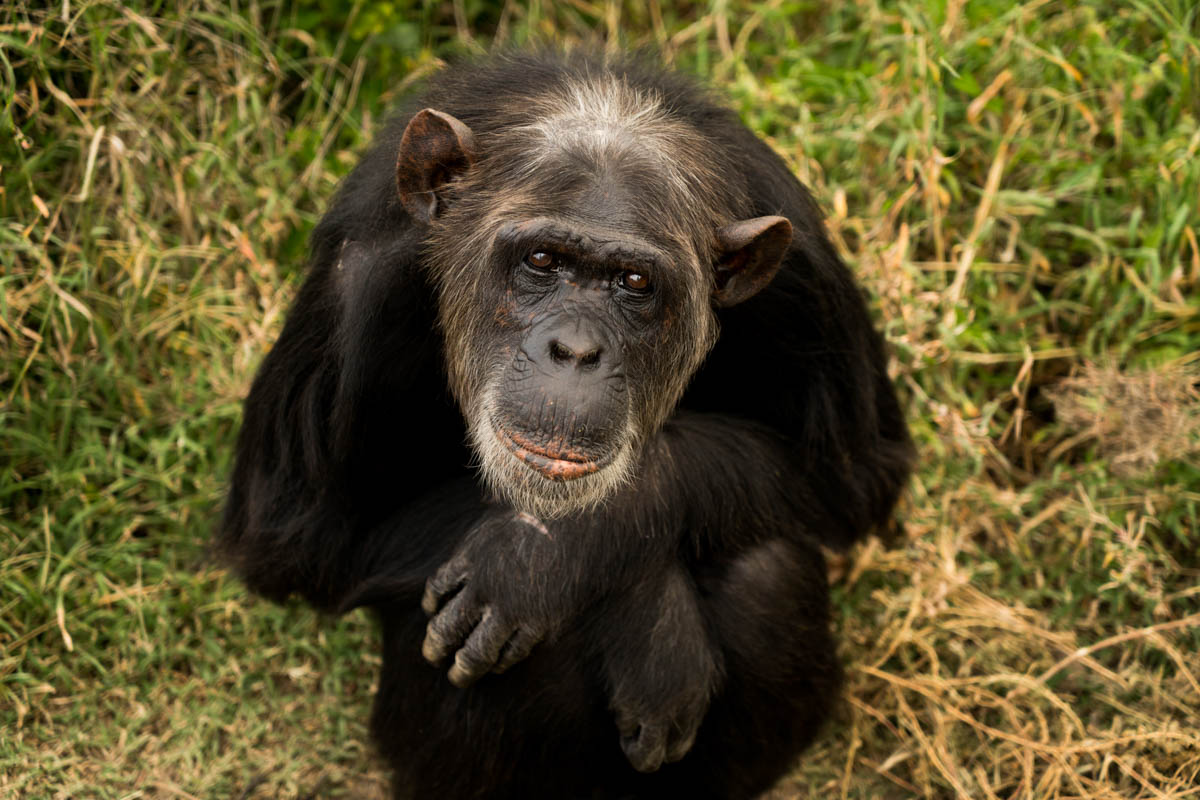![The chimps catch their breakfast of papaya, oranges and bananas through the fence. [Adriane Ohanesian/Al Jazeera]](https://www.aljazeera.com/mritems/Images/2018/5/8/6822ff99646c454083c86e2892121983_8.jpg)
Laikipia County, Kenya – William was sprawled out on his back, dozing off for the night in his bed of hay, provided for him by his keepers at the Sweetwaters Chimpanzee Sanctuary in northern Kenya.
The other chimps in the enclosure were still perfecting their neatly packed nests, a talent they acquired from their family members in the wild, but William never learned how to build a bed.
As his eyes closed, he rocked his head back and forth. Despite his meditative appearance, you could tell that he was not at peace.
“We don’t know what happened to him in Sudan, but he has been traumatised,” said one of his keepers.
In 2003, William had been rescued from a Catholic relief mission on the border between Sudan and Uganda, where he had been confined to a cage.
Like many of the 35 chimpanzees at the sanctuary, William had been a victim of the illegal pet trade, but no one knew how he had been taken from the wild.
Orphaned and abused
The Sweetwaters Chimpanzee Sanctuary provides a refuge for rescued, orphaned and abused chimps who are often psychologically or physically scarred, and allows them to live like chimpanzees again in a stress-free environment.
When they arrive at the sanctuary, the chimps lack many of the skills needed to survive in the wild.
Like William, some have never built a sleeping nest.
Others do not know how to hunt or eat leaves off of a tree.
Some have broken bones or bullets lodged in their bodies, while others are deathly ill or psychologically traumatised after witnessing the slaughter or capture of their family members.
Many of the chimps have picked up human behaviours such as walking, clapping, spitting, or smoking. Some even fear other chimpanzees.
After spending the night in the enclosure, William and the others wait to receive their breakfast.
Meal of fruits
As their names are called, the chimps walk over to their caregivers and hold out their hands to receive their meal of oranges, papayas, and bananas.
Then, they take off into their 250-acre jungle reserve.
Poco, a chimp from Burundi, chooses to stay close to the fence to interact with tourists who have come to visit the sanctuary.
Poco struts, bipedal, along one side of the fence as a Kenyan family walks along the other.
The caregiver explained that Poco spent the first nine years of his life confined to a cage and surrounded by humans and, as a result, even at the age of 37, he prefers to be around people and often walks upright.
“He’s exactly my age,” one of the women remarked.
“He’s the age of one of my children,” joked another as they continued to stroll with Poco.
Native to West and Central Africa, chimpanzees are not usually found in Kenya, but this group of refugees have made the sanctuary their home.
Captured for trade
The chimps were rescued from South Sudan, Rwanda, Burundi, Congo, Cameroon, and Mozambique, and some were brought back to the continent from as far away as Iraq and the United Arab Emirates.
Displaced or uprooted from their homelands, these chimpanzee refugees will never return to their native countries.
Their habitats are continuously threatened by deforestation due to logging, human settlements and war.
Even when their jungle homes appear to be safe, they are in danger of being killed for their meat while their young are captured for trade.
The UN estimates that 3,000 chimps die each year while being illegally trafficked to be used as pets, in zoos, or in safari parks.
Chimpanzees have now disappeared from four of their native countries in Africa.












![Seven-year-old Angela, who was born in the sanctuary, swings from an acacia tree at the Sweetwaters enclosure in Laikipia County, Kenya. [Adriane Ohanesian/Al Jazeera]](https://www.aljazeera.com/mritems/Images/2018/5/8/7ddfcd8d66c6414389882121cd7af6b4_8.jpg)
![Joseph Maiyo, 56, has worked at the sanctuary since it was set up in 1993. To show the chimps affection, he mirrors their 'thank you' gesture after giving them their breakfast at the Sweetwaters Chimpanzee Sanctuary. [Adriane Ohanesian/Al Jazeera]](https://www.aljazeera.com/mritems/Images/2018/5/8/97ddb3e0172543ff9d2524ea3ff5f731_8.jpg)
![Chippie, 26, who was illegally taken from Congo, sits near the fence as she waits for her breakfast. [Adriane Ohanesian/Al Jazeera]](https://www.aljazeera.com/mritems/Images/2018/5/8/e35547f21f5a44ce800306cc7974266e_8.jpg)
![A chimp catches sweet potatoes at the Sweetwaters enclosure. [Adriane Ohanesian/Al Jazeera]](https://www.aljazeera.com/mritems/Images/2018/5/8/fe5e7f03aced4f289a2554504f9824b9_8.jpg)
![Timothy Mwangi, 44, and a six-year-old chimp named Manno hold hands. Mwangi has worked with the chimps since 1995 while Manno was rescued from the Duhok Zoo in Iraq and brought to the Sweetwaters Chimpanzee Sanctuary. [Adriane Ohanesian/Al Jazeera]](https://www.aljazeera.com/mritems/Images/2018/5/8/a7236cf60c824de4921271d9c0026ddb_8.jpg)
![Manno, age six, the newest and youngest member of the group is not yet comfortable going far into the jungle from the enclosure and instead spends time with one of his keepers in the Sweetwaters Chimpanzee Sanctuary. [Adriane Ohanesian/Al Jazeera]](https://www.aljazeera.com/mritems/Images/2018/5/8/6e085996e6c74cd69f3427846623f6d3_8.jpg)
![Jane, age 14, relaxes before dinner in her enclosure. She is originally from Cameroon and was confiscated from the airport in Kenya with a shotgun pellet in her finger, malnourished, and dehydrated. [Adriane Ohanesian/Al Jazeera]](https://www.aljazeera.com/mritems/Images/2018/5/8/0b35b03cd96e48d4918919efa1a1c6ed_8.jpg)
![Amahirwe, age 19, from Rwanda, sleeps in his enclosure. [Adriane Ohanesian/Al Jazeera]](https://www.aljazeera.com/mritems/Images/2018/5/8/ba77e7f014a44f5f9f643d708d3c901d_8.jpg)
![Chimps come out of the jungle and wait outside their enclosure before dinner is served at the Sweetwaters Chimpanzee Sanctuary. [Adriane Ohanesian/Al Jazeera]](https://www.aljazeera.com/mritems/Images/2018/5/8/5bb1b287ab4f415c9a957cd25df21a4d_8.jpg)
![At the end of the day, one of the chimpanzee keepers walks back to his house in the Ol Pejeta Conservancy, home of the Sweetwaters Chimpanzee Sanctuary in Laikipia County. [Adriane Ohanesian/Al Jazeera]](https://www.aljazeera.com/mritems/Images/2018/5/8/63982a4afd054a4c8fd58140000aefca_8.jpg)
![Rangers and chimp keepers play pool in the evening at the Ol Pejeta Conservancy. [Adriane Ohanesian/Al Jazeera]](https://www.aljazeera.com/mritems/Images/2018/5/8/1b172c0a121f4790bce872d374598c2c_8.jpg)
![The chimps eat breakfast before taking off into the jungle for the day. [Adriane Ohanesian/Al Jazeera]](https://www.aljazeera.com/mritems/Images/2018/5/8/c542fa7559364905844496b4fcaf26f4_8.jpg)
![Poco, age 37, who spent nine years of his life in a cage in Burundi only big enough for him to sit or stand on two feet, walks around the edge of the enclosure in the Sweetwaters Chimpanzee Sanctuary. [Adriane Ohanesian/Al Jazeera]](https://www.aljazeera.com/mritems/Images/2018/5/8/25e93c4052b447339dadd3fe304b2416_8.jpg)














